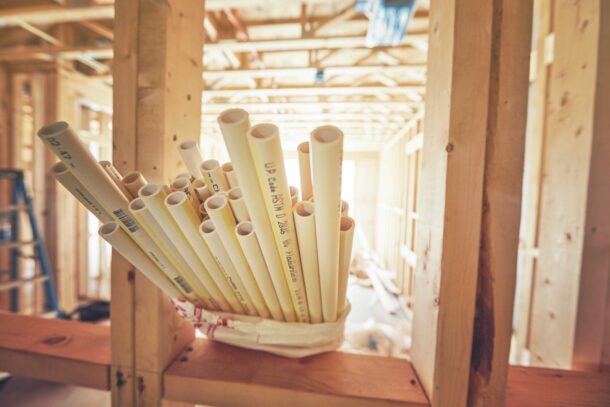By Jonathan Simon Most homeowners don’t think about the plumbing materials in their homes until a problem occurs. Yet, plumbing materials play a significant role in their day-to-day quality of life, especially when the system doesn’t deliver on their expectations. Some plumbing systems can contribute to issues like poor water pressure and water quality. Then Read more
Water Quality

By Jonathan Simon
Most homeowners don’t think about the plumbing materials in their homes until a problem occurs. Yet, plumbing materials play a significant role in their day-to-day quality of life, especially when the system doesn’t deliver on their expectations.
Some plumbing systems can contribute to issues like poor water pressure and water quality. Then, of course, there are the reliability problems that can arise when the plumbing system proves incompatible with local water conditions, leading to failures and water damage that can turn a homeowner’s life upside down.
So, while homeowners don’t spend much time thinking about plumbing materials, plumbers should. Here are four ways that you can protect your customers thanks to the performance of CPVC.

Water Pressure
Low water pressure can be frustrating for homeowners every time they shower, and the design of the plumbing system could be a contributing factor.
Plumbing systems using insert fittings where the fitting goes into the pipe will reduce the system’s diameter at the fitting, restricting flow and creating a much larger pressure loss than occurs with systems where the pipe is inserted into the fitting, such as CPVC and copper. Even expansion fittings, which have the largest internal diameter of the insert fittings, can cause up to 7x more pressure loss in the system compared to a CPVC or copper fitting.
Insert fittings can also create turbulent zones in the pipe as water jets out of the restriction created by the fitting. These higher-velocity zones may require that the design velocity of the system be reduced to remain within manufacturer specifications.
Plumbers can compensate for the issues created by insert fittings by upsizing piping, but that adds significant cost to projects. Using larger pipe to slow down the water and reduce pressure drop can also pose challenges in areas that need to comply with water and energy efficiency standards. By minimizing pressure drop across the system, CPVC helps preserve water pressure at fixtures.
Water Quality
No plumbing system can improve water quality, but the choice of materials can minimize the risk of various sources of contamination.
One of those risks is biofilm growth. Biofilm that forms inside residential plumbing systems can contain bacteria such as E. coli, coliforms and legionella. The susceptibility of a particular material to biofilm is called its biofilm formation potential and varies across materials. Independent research has found that CPVC has a lower biofilm formation potential than other plastic plumbing systems and is consistently among the lowest of plumbing systems tested.
Permeation and leaching also present risks to residential water systems. Materials vulnerable to permeation can allow dangerous chemicals that come in contact with the outside of the pipe to enter the water supply. The U.S. EPA, in their study on Permeation and Leaching, found that vinyls such as CPVC are virtually impermeable at low levels of exposure and that polyolefin plastic plumbing materials accounted for more than three-quarters of the documented permeation incidents in the United States.
NSF 61 is the industry standard for protecting against unsafe leaching of chemicals from plumbing materials into the water supply. FlowGuard Gold CPVC is certified to NSF 61 under all water conditions. Copper and some PEX brands have limitations on their NSF 61 listings.
By reducing the risks from biofilm formation, permeation and leaching, plumbers play an important and underappreciated role in protecting the health of their customers. And while homeowners may never fully appreciate that role, they could notice the difference in water quality when materials other than CPVC are used. According to research from Virginia Tech, CPVC has the lowest impact on drinking water taste and odor of any residential plumbing material.
Reliability
In addition to good pressure and water quality, homeowners want a plumbing system they don’t have to worry about. If there’s one thing more frustrating than a water leak, it’s having a second leak soon after the damage from the first has been repaired. That was the experience of the Jackson family in Battle Ground, Washington. They had multiple plumbing system failures, one after the other, until an expert finally diagnosed the root cause of the problem as incompatibility between the plumbing material chosen for their ten-year-old home and local water conditions. When the home was repiped with CPVC, the problems disappeared.
CPVC is the only residential plumbing material that is naturally immune to chlorinated drinking water. As municipalities strive to maintain water safety through treatment methods that produce higher oxidative reduction potential in the water they supply, this is more important than ever. CPVC can perform reliably in water conditions and at temperatures, pressures and velocities that could lead to degradation and early failure in other plastic or metal plumbing systems.
Sustainability
For homeowners that prioritize the sustainability of building materials, CPVC is a very attractive choice. Based on comparisons using the National Institute of Standards (NIST) BEES software, FlowGuard Gold CPVC requires less energy to manufacture, has lower embodied energy and results in fewer emissions over its service life than PEX and copper. CPVC is also recyclable through proper centers.
In addition, FlowGuard Gold CPVC is the only residential plumbing system certified by Home Innovation Labs National Green Building Standard (NGBS) and has a lifecycle assessment to enable the material to contribute to LEED certification.
Making the Right Choice
If you’re looking to give your customers the water quality, pressure, reliability and sustainability they are looking for, CPVC is the right choice. And CPVC doesn’t just deliver benefits to homeowners. Plumbers experience lower material costs, faster installation and excellent support from leading manufacturers. To learn more, visit flowguardgold.com/plumber-resources.
Jonathan Simon is the North American residential plumbing manager for Lubrizol Advanced Materials. Half of the world’s consumers use at least one product containing a Lubrizol ingredient. Advanced materials products create and/or improve the performance of our customers’ products and enable unique performance attributes. For 60 years, FlowGuard Gold Pipe and Fittings have provided reliable hot and cold water plumbing systems to residential and commercial buildings.
Mokena, Ill. — ASSE 1090-2020, Performance Requirements for Drinking Water Atmospheric Water Generators (AWG), has been designated as an American National Standard by the American National Standards Institute (ANSI) and is now available for purchase. ASSE 1090 was created to test point of use and commercial drinking water generating devices, which are designed to create Read more
Mokena, Ill. — ASSE 1090-2020, Performance Requirements for Drinking Water Atmospheric Water Generators (AWG), has been designated as an American National Standard by the American National Standards Institute (ANSI) and is now available for purchase.
ASSE 1090 was created to test point of use and commercial drinking water generating devices, which are designed to create potable water from atmospheric humidity. Critical components of these devices include a condenser, storage tank, and filtration/disinfection controls to address potential chemical, particulate, and microbiological water contamination. The standard also includes consideration for the energy efficiency of the AWG.
ASSE 1090 started its life as ASSE LEC 2004-2019, Listing Evaluation Criteria for Drinking Water Treatment Systems Using Air as a Source. ASSE International Listing Evaluation Criteria (LEC) documents provide manufacturers with an avenue to certify unique, novel products that do not fit the scope of an existing standard. If these products gain traction and market acceptance, the LEC can then be developed into an ASSE Standard through the ANSI-accredited standards development process. ASSE 1090 is one example of an LEC that has gone through the process of becoming an ASSE American National Standard.
With AWG products, water-from-air becomes a real source of water supply in places where tap water is not available, or the quality of the tap water does not meet the consumer’s requirements. Creating a product performance standard to help ensure that these products produce safe, potable water was desired by the water treatment industry.
“Standards legitimize an industry and should also make it easier to assess solution providers,” said Frank A. Brigano, Ph.D., ASSE 1090 Working Group Member and Vice President, Senior Research Fellow, at Marmon Water, a division of Berkshire Hathaway. “The beauty of AWG systems is that they are disconnected from municipal systems and their inherent ‘issues.’ Thus, making claims of ‘free from heavy metals and organics, worry-free from boil water warnings, PFAS, etc.,’ is what makes these systems attractive.”
To become a source of drinking water under this standard, the water-from-air should meet two primary criteria:
1) The water should be produced for a reasonable cost so that it’s affordable to the user. The cost of the water is based on the energy efficiency of the atmospheric water generator system — electrical energy consumption per liter of water produced.
2) The water quality produced by the atmospheric water generator must be safe to consumers.
To purchase ASSE 1086, please visit the ASSE International Webstore at www.assewebstore.com.

Copper to replace Flint’s lead and lead-tainted galvanized iron service lines Mayor Karen Weaver and FAST Start Coordinator Michael C. McDaniel told hundreds of participants attending the Flint Water Infrastructure Summit this week that copper pipe will be used to replace the City of Flint’s entire lead and lead-tainted galvanized iron service lines. “We chose Read more
Copper to replace Flint’s lead and lead-tainted galvanized iron service lines
Mayor Karen Weaver and FAST Start Coordinator Michael C. McDaniel told hundreds of participants attending the Flint Water Infrastructure Summit this week that copper pipe will be used to replace the City of Flint’s entire lead and lead-tainted galvanized iron service lines.
“We chose copper because the residents of Flint deserve a high quality engineered material that has a history of safely conveying drinking water,” Weaver said. “With copper, we know we’re getting a long-term solution.”
McDaniel said that the decision was made after a number of factors were considered, especially the longevity of the piping and the lifetime cost of the product.
“This was a very important decision that will affect many generations to come,” McDaniel said. “My team and I conducted months of research and engaged in conversation with piping experts regarding the ideal lead replacement material for superior performance.”
The City concluded that copper was the best material for the replacement pipes because it’s durable, reliable and long-lasting. Copper piping is also impermeable, so outside chemicals such as petroleum products spilled on nearby streets or insecticides and fertilizers spread on yards can’t contaminate the water system.
Following the City’s determination, the copper industry banded together to help Flint acquire nearly 200,000 feet of copper piping, at a savings of approximately $1 million to the City, for the next phase of the FAST Start program, due to start in April.
“The copper industry will continue to provide technical guidance and educational resources wherever needed to ensure that copper piping is designed, installed and operated properly every step of the way,” said Andrew G. Kireta, Jr. of the Copper Development Association (CDA). “We are committed to helping America rebuild its aging water infrastructure.”
CDA exhibited at the Flint Water Infrastructure Summit and was selected as a speaker for the Water Infrastructure 101 Workshop. Kireta gave two, 20-minute presentations on “Why Copper is the Right Choice” for lead service line replacements and hosted an open forum to interact with attendees on questions related to this topic.
For more information about copper piping, visit www.copperservicelines.org.
Today’s high-efficiency hydronic heating systems rely on optimal water quality to maintain peak performance. Iron oxide sludge, also called magnetite, can destroy water quality and, in turn, affect total system health. This black sludge is an unavoidable result of oxidation inside untreated hydronic systems, and it can cause loss of system efficiency and expensive damage Read more
Today’s high-efficiency hydronic heating systems rely on optimal water quality to maintain peak performance. Iron oxide sludge, also called magnetite, can destroy water quality and, in turn, affect total system health. This black sludge is an unavoidable result of oxidation inside untreated hydronic systems, and it can cause loss of system efficiency and expensive damage. According to Dr. Neil Watson, ADEY® Global Technical Director, “Nearly 70 percent of circulator pumps returned to pump manufacturers fail due to iron oxide and other water quality issues. Data also show that over 95 percent of debris in hydronic heating systems is made up of iron oxide.”
ADEY, a U.K.-based company launched in 2003, is introducing MagnaClean Micro2™ to the North American market to protect total system health. It features a unique, patented magnetic filtration system that, within minutes of installation, begins to capture and remove virtually all of the suspended iron oxide that collects in hydronic heating systems, restoring optimal water quality. MagnaClean Micro2 is specifically designed for smaller installations, making it ideal for tight spaces.
Designed for ¾-inch copper and ¾-inch NPT iron pipework, the MagnaClean Micro2 is suited for baseboard and smaller residential installations. The compact unit is easily fitted on the return pipe to the boiler/circulator via rapid-fit connectors. It can be installed in minutes and serviced even faster, due to the unit’s quick-release trigger, low-profile drain valve, and built-in air vent.
As contractors become all too familiar with the damaging effects of iron oxide sludge on today’s high-efficiency commercial hydronic heating and cooling installations, the need for a solution has been growing. ADEY® Professional Heating Solutions is answering that need with the introduction of the MagnaClean Commercial™ Magnetic Filter range to the North American market. MagnaClean Read more
As contractors become all too familiar with the damaging effects of iron oxide sludge on today’s high-efficiency commercial hydronic heating and cooling installations, the need for a solution has been growing. ADEY® Professional Heating Solutions is answering that need with the introduction of the MagnaClean Commercial™ Magnetic Filter range to the North American market.
MagnaClean Commercial’s unique, patented magnetic filtration system starts to work immediately upon installation, removing virtually all of the suspended iron oxide that collects in hydronic heating systems. “The removal of iron oxide is facilitated simply by the flow of water through a central magnetic core, which is populated by a series of magnetic rods inside the canister,” says Dr. Neil Watson, ADEY Global Technical Director.
By removing sludge from the system, MagnaClean Commercial restores peak performance and decreases maintenance costs over the life of the system. It also offers a solution for the most common complaints in commercial hydronic systems, including poor system circulation, blocked system pipes and radiators, and excessive system noise.
